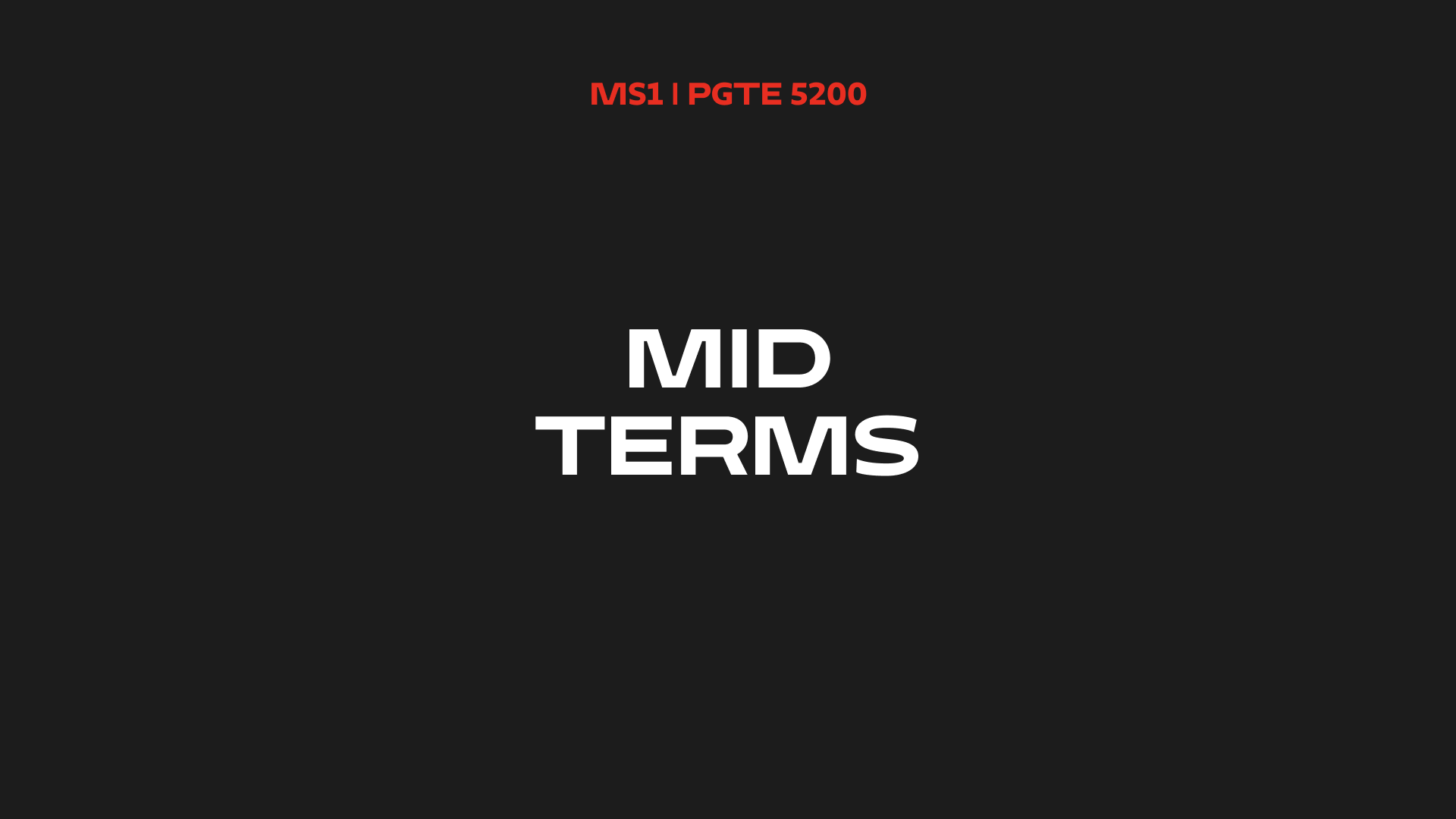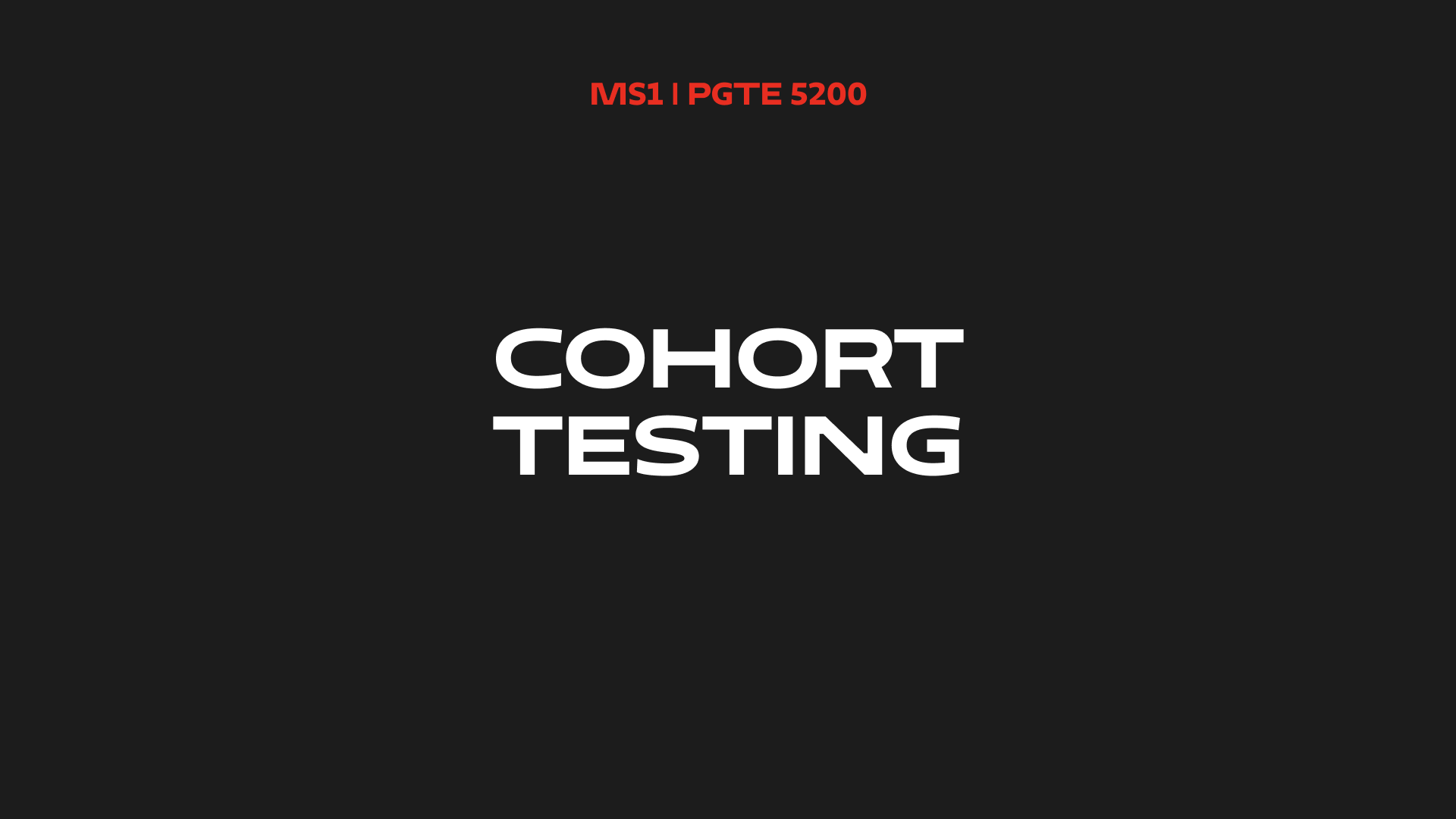The scent-jet
Studio Project
Major Studio 1 | PGTE 5200
MFA Design & Technology
Parsons School of Design | The New School
Advisor: Harpreet Sareen
The scent-jet v1
The first prototype wasn’t a functional prototype. It has a peristaltic pump to make it look that it is pumping oil from the bottle to the tank. The testing was conducted using the wizard-of-oz method, by asking testers to write a ratio, and myself mixing the essential oil manually according to the given ratio.
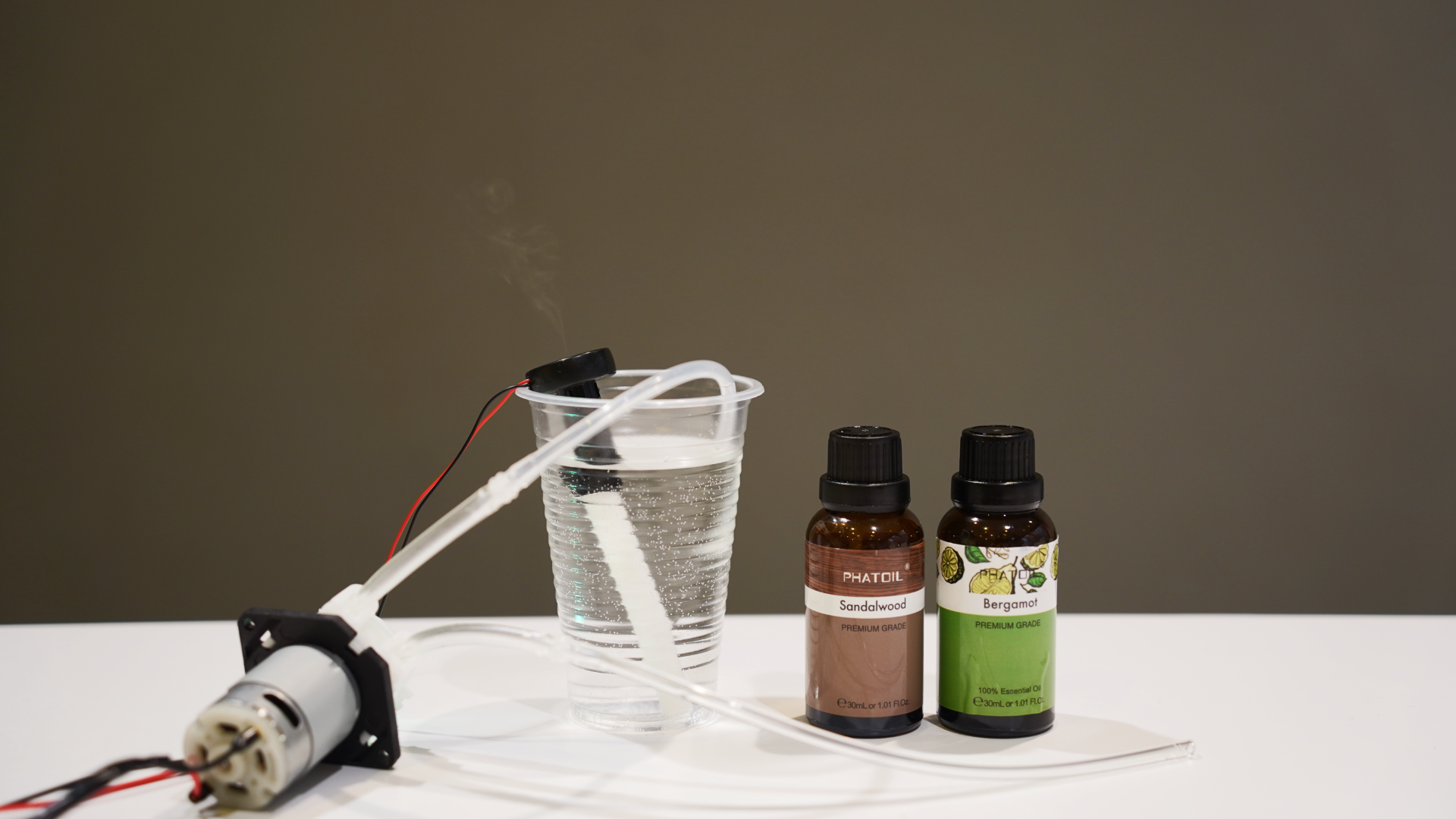
Other attempts
Servo Motor
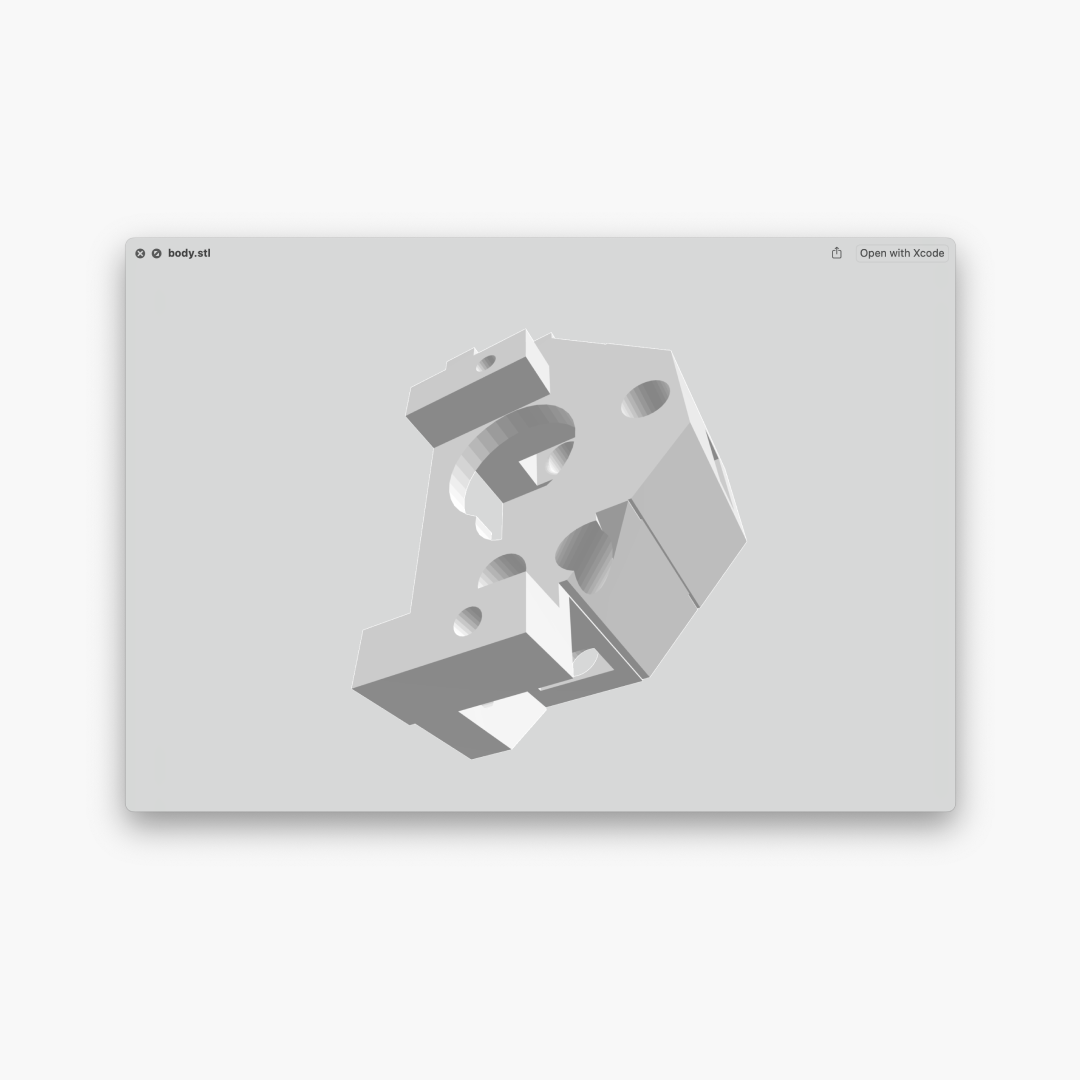
Since the 12V peristaltic pumps are large and bulky, I tried to find a smaller option. One of the ideas I got from my feedback was a IV valve, which is very small, silent, and functional at the same time. In order to control a valve digitally, I found a servo valve online. The model only suited a tube with a small diameter, I tried to adjust it to be suitable for a larger tube. In conclusion, I failed; servo motors didn’t have enough power to move through.
Modular Design
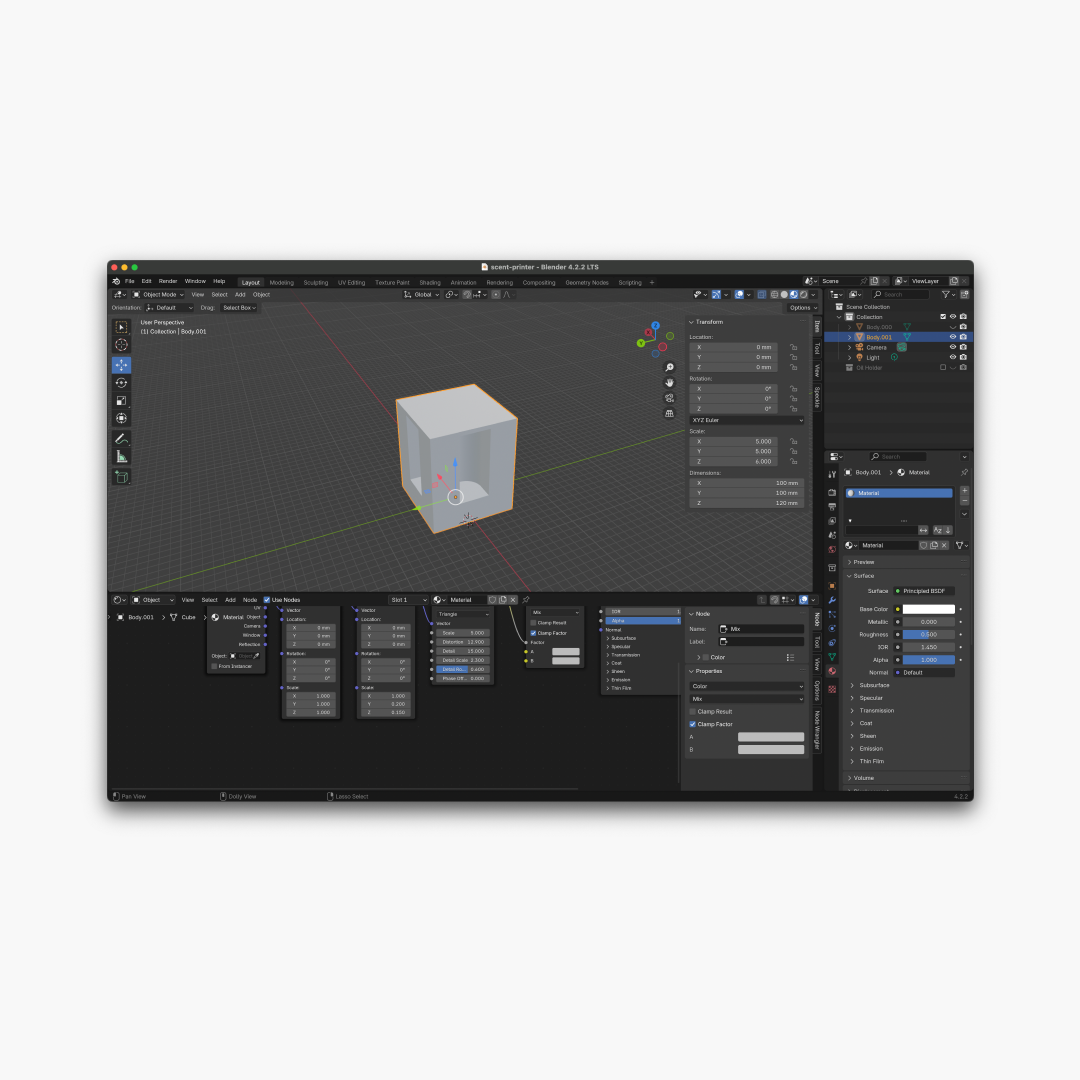
I tried to make a modular design for the scent-jet, so that it is scalable and could mix more than 4 scents. Although I tried to come up with the design, it was difficult since I had no prior experience in circuit building and industrial design. I couldn’t find an option that could make it function the way I want it to and be compact/modular at the same time.
The scent-jet v2
The second prototype, scent-jet v2 is a functioning prototype. The pumps are connected to a relay, that is controlled by an Arudino. The Arduino code maps an inputed ratio and matches it to the right amount of essential oil.
Although this prototype was functional, it had a lot of limitations;
- The user has to hold the bottles upside down in order to make the oil flow, which caused it to spill sometimes.
- The board wasn’t stable. It could be dangerous to hold a water-filled cup on top of the cardboard base.
- The water atomizer isn’t connected to any digital input. It has to be turned on manually.
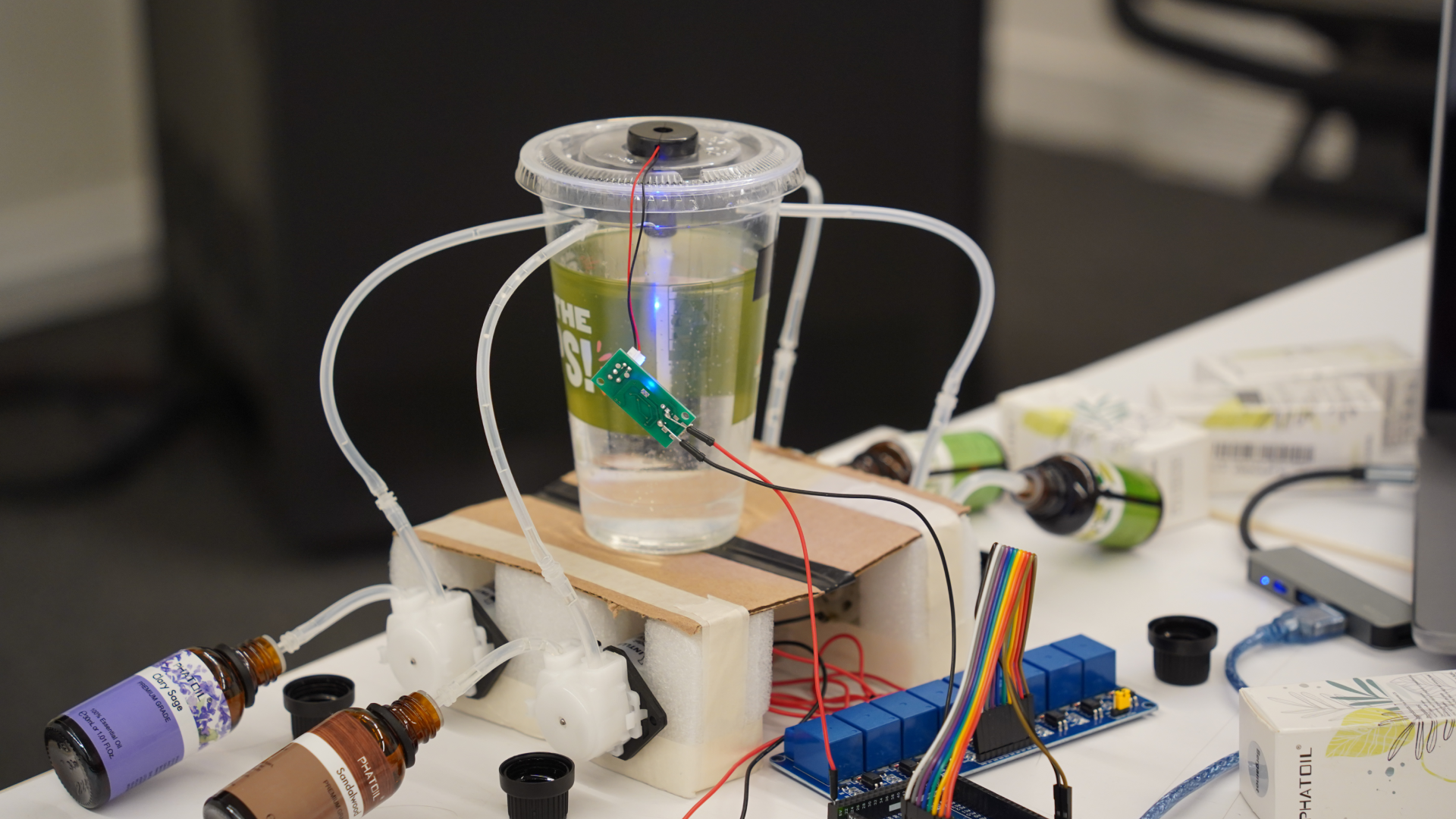
Code | Arduino
// Write down the name of the scent
//scentA = clarysage;
//scentB = bergamot;
//scentC = sandalwood;
//scentD = teatree;
//Write down the ratio of the scent, 0-100 each
int scentARatio = 50;
int scentBRatio = 50;
int scentCRatio = 100;
int scentDRatio = 0;
// Do not edit below this line
//------------------------------------------------------------------------------------------------
const int pumpA = 2;
const int pumpB = 3;
const int pumpC = 4;
const int pumpD = 5;
const int scentA = pumpA;
const int scentB = pumpB;
const int scentC = pumpC;
const int scentD = pumpD;
float addedRatios = scentARatio + scentBRatio + scentCRatio + scentDRatio;
int scentMapped = map(addedRatios, 0, addedRatios, 0, 400);
int scentMappedA = (float)scentARatio / addedRatios * scentMapped * 5;
int scentMappedB = (float)scentBRatio / addedRatios * scentMapped * 5;
int scentMappedC = (float)scentCRatio / addedRatios * scentMapped * 5;
int scentMappedD = (float)scentDRatio / addedRatios * scentMapped * 5;
void setup()
{
Serial.begin(9600);
pinMode(scentA, OUTPUT);
pinMode(scentB, OUTPUT);
pinMode(scentC, OUTPUT);
pinMode(scentD, OUTPUT);
// Print values once
Serial.println(scentMapped);
Serial.println(scentMappedA);
Serial.println(scentMappedB);
Serial.println(scentMappedC);
Serial.println(scentMappedD);
// Default State
digitalWrite(scentA, HIGH);
digitalWrite(scentB, HIGH);
digitalWrite(scentD, HIGH);
digitalWrite(scentC, HIGH);
delay(2000);
// Load tube
digitalWrite(scentA, LOW);
digitalWrite(scentB, LOW);
digitalWrite(scentD, LOW);
digitalWrite(scentC, LOW);
delay(1000);
// Pause
digitalWrite(scentA, HIGH);
digitalWrite(scentB, HIGH);
digitalWrite(scentD, HIGH);
digitalWrite(scentC, HIGH);
delay(1000);
// A
digitalWrite(scentA, LOW);
delay(scentMappedA);
digitalWrite(scentA, HIGH);
// B
digitalWrite(scentB, LOW);
delay(scentMappedB);
digitalWrite(scentB, HIGH);
// C
digitalWrite(scentC, LOW);
delay(scentMappedC);
digitalWrite(scentC, HIGH);
// D
digitalWrite(scentD, LOW);
delay(scentMappedD);
digitalWrite(scentD, HIGH);
}
void loop()
{
}
Testing
I asked fellow students for testing. Testers understood how to use the device while it was connected to a screen showing an editor with example ratios on top. They enjoyed how the pump was mixing the oil; it had a rough spinning sound and seemed to be almost ‘spitting’, as they mentioned, out the oil.
Feedbacks
All testers agreed it was hard to hold up the essential oil bottles upside down without spilling it. Some thought it could be even better if the humidifier was also connected to a digital pin of the Arduino, so it starts operating after the mix of scents.
Improvements
After testing out the 2nd version of the scent-jet, I planned on making a 3D printed housing for it. With the feedbacks, I also tried to find ways to connect the the humidifier to a digital pin, without having to use a breadboard. Aside from the feedback, it looked like they struggle a little while trying to understand how to use the device. So a GUI would be necessary to make it easier to use.
The scent-jet v3
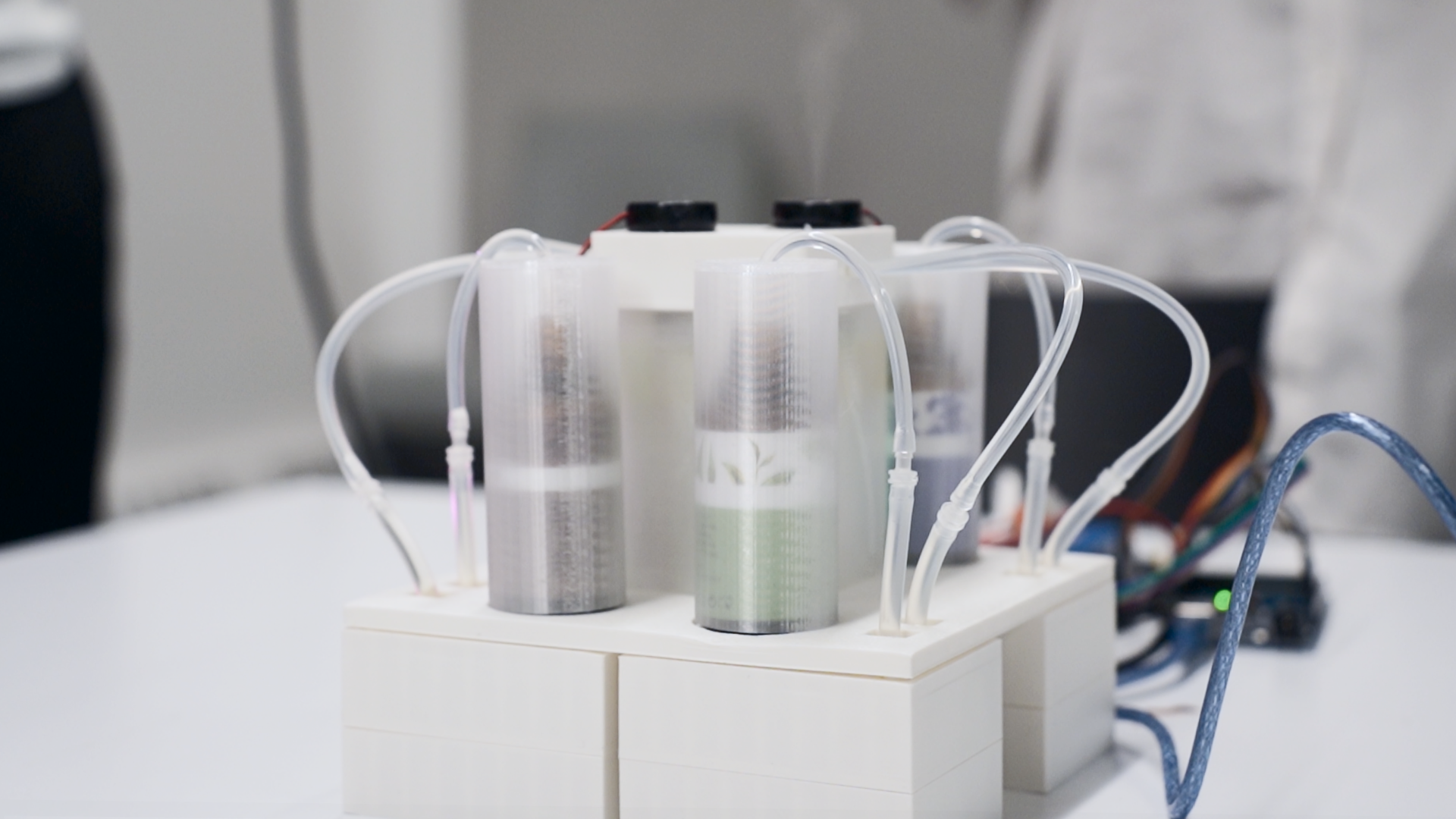
The scent-jet v3, which is the last prototype made within the semester, had improved stability, housing and aesthetics. Due to time constraints, some of the improvement points addressed on v2 weren’t developed.
3D Model | Blender
Upgrades
For scent-jet v3, a 3D printed housing was added to improve the user experience from the previous version. A slot was made to hold the water tank and the essential oil bottles in place. The wiring was improved with stronger wires. A longer tube was added on the oil side of the pump, in order to pump the oil without having to hold the bottle by hand.
Improvements
Some of the improvement points from v2 still has to be added. I did find a way to connect the humidifier to a digital pin through soldering, but I needed to connect it to a transistor, meaning it would need a breadboard to connect. I should try to find another way to accomplish this without the need of a transistor. + I still have to improve the GUI, which is currently just the Arduino IDE.
Finals Feedback
Good story
I got feedbacks that it was great to see how my personal experience from childhood motivated me to start this whole project.
Focused on function
However, the final outcome didn’t convey the meaning that started this project. It was more focused on the functionality, and making it work.
Want to see more
Feedbacks from classmates says that they would like to see how this used in real-life environment.
Full Feedback
Classmate 1
- Super good presentation
- Your prototype is really well put together would love to see the other ways you can house it
Classmate 2
- I like your prototype! Really clean and neat!
- Maybe you can do some research on social cultural aspect of smell
Classmate 3
- Neat presentation!
- Great to see how your final prototype looks (looks good)
Classmate 4
- Clear narrative (+1 Classmate2)
- I would like to see what you want to question and what kind of interaction you want to make by letting people use the product since you’re now exploring interaction more than just visual design 🙂
- I could imagine tons of iterations before you get it done
Classmate 5
- The effort put into making all the electronics working is very impressive!
- It would be really cool if you use more everyday scents for the demo: like fireplace, rain, cooking rice, etc.
Classmate 6
- Each iteration is really necessary and useful.
Classmate 7
- Well-researched preface about scent and smell
- The prototype is impressive and it’s interesting to put all scent together. Curious about feedback you got from testing
Classmate 8
- I really like your prototype. I think you are almost there. If you create a box and an interface of this project it will be like a professional commercial product.
- I am thinking of making the product more interesting. I’m not sure if you are interested in incorporating synesthesia into your project—for example, changing the color of the interface when the scent is released or adding other elements to work alongside the scent to enhance the immersive experience.
Classmate 9
- Neat and well-researched
- Would be interesting to have a product that makes a diverse range of scents
Classmate 10
- Appreciate the prototype showing / trying section inside a presentation.
Critic 1
- Good prefacing of smell; leading to your creative question(s)
- I think your question about ‘how can we create’ is about creation - to which the answer will be a creation. However, I think what you want to achieve through this scent mixing should instead be foregrounded, with the creation/making serving as a conduit.
- I think your feedback reflects this too -
- Highlighting what you want to achieve w/ smell is more important than getting the hardware for the ratios perfect
Critic 2
- Looks like you’re learning a lot - great that you’re capturing the process
- It’d be good to show the failures too in this presentation
- Super fascinating area: Related things: Judith’s scent memories (related and relevant piece) Long history of scent: Go further in the books - jacky mory?
- Pioneer for VR - scent caller to recreate environments specifically in PTSD rehab Soldiers - virtual environments is capturing smell - not just visual
- Making scents: Demeter? Grass cologne Expanded their offerings Vast library that has been recreated
- Wanted to provide more feedback / input - the more specific you go, the better the feedback
- User testing:
- Didn’t need your hardware to test
- You’re the computer - test it!
- Least smallest thing, realize and then iterate
- How am I getting there?
- Yak Shaving? Rabbit-hole to fix all of these things
- Meander, but come back to the original task
Critic 3
- Ask “Why am I making smells?”
- Scoping and scaling is very important too
- Another rube goldberg machine, and learnt a ton in the process
- Agreed: Least understood, and more often dismissed
- Aristotle: Dismissing the sense of smell, never gained a footing 2500 years later too
- Lack of language we have to talk about it,
- Taste: Deeply interconnected to taste
- Piper Wu: Investigating the feeling - of being in wet pants - as a six year old
- Ask “Why am I making smells?”
- Try to remind yourself - what started this
Reflections
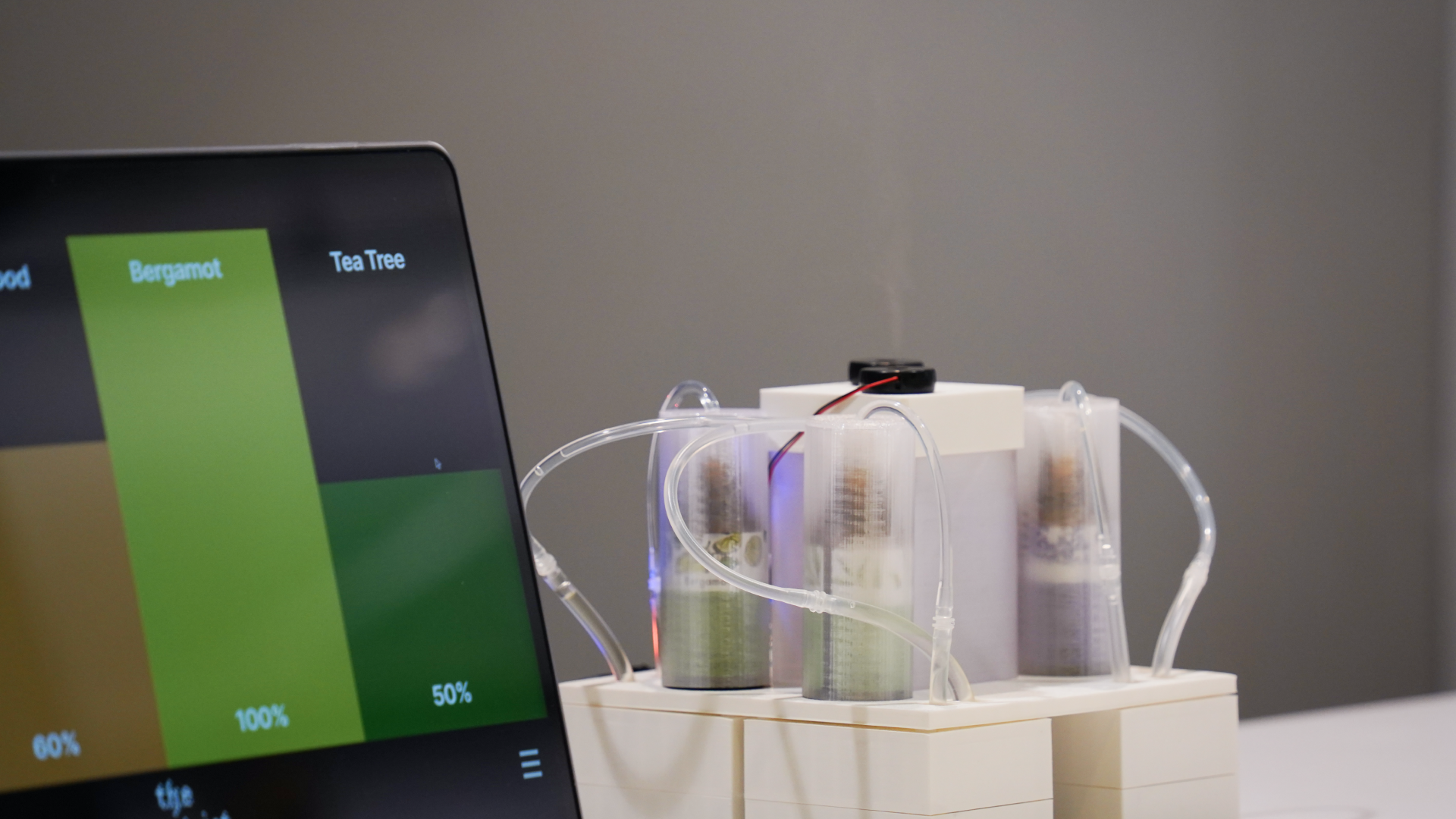
Endless Learning
A lot of the tools and methods I tried out during this project were new to me. I had no prior experience in using Arduino or electronics, it was also my first time using 3D tools and a 3D printer. And of course, I never thought about olfactory interaction before. Through this project, I was able to expand my capabilities on fabricating my ideas.
Yak Shaving
Although I learned a lot, I was drawn away from my initial motivations. I started this because I want to recreate the smell that I like. Which wasn’t conveyed in my final outcome. I was able to make a device that could possibly do that, but I was driven away by just trying to make it work and functional.
Going back to the motivation
I learned that I should always ask myself how and why I started the project. I did get frustrated and tired because I failed so many times just to figure out how to make this work. The important part wasn’t about the device working, it was about how I recreated the scent that brings me memories and perhaps others with theirs as well.
Footnote.
Thanks again to everyone that gave me feedbacks, and all my wonderful classmates/instructors who helped me out throughout the project.

